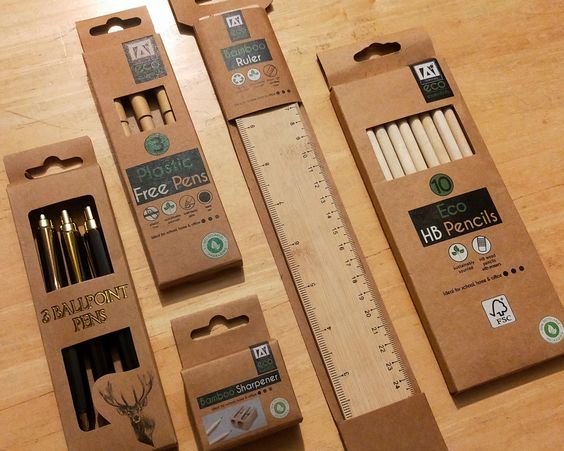
In today’s world, where environmental concerns are at the forefront of our minds, it is important to consider the impact of our everyday choices, including the stationery we use. Eco-friendly stationery is a sustainable and responsible choice that can make a significant difference in reducing our carbon footprint and preserving the environment for future generations.
Traditional stationery, such as paper and plastic pens, have a negative impact on the environment. The production of paper involves cutting down trees, which contributes to deforestation and habitat destruction. Additionally, the manufacturing process requires large amounts of water and energy, leading to pollution and greenhouse gas emissions. Plastic pens, on the other hand, are made from non-renewable resources and take hundreds of years to decompose in landfills.
Choosing Sustainable Materials for Your Stationery
Sustainable materials are those that are sourced and produced in a way that minimizes harm to the environment and promotes long-term ecological balance. When it comes to stationery, there are several sustainable materials to choose from.
One popular option is bamboo. Bamboo is a fast-growing grass that can be harvested without killing the plant, making it a highly renewable resource. It also requires less water and pesticides compared to traditional wood sources. Bamboo can be used to make pens, pencils, notebooks, and other stationery items.
Another sustainable material is recycled plastic. By using recycled plastic in the production of stationery, we can reduce the demand for virgin plastic and prevent it from ending up in landfills or oceans. Recycled plastic can be used to make pens, rulers, and other plastic-based stationery items.
Recycled Paper: The Key to Eco-Friendly Writing
One of the most important aspects of eco-friendly stationery is using recycled paper. Recycled paper is made from post-consumer waste paper that has been processed and reformed into new paper products. By using recycled paper, we can reduce the demand for virgin wood pulp and save trees.
Recycled paper offers several benefits. Firstly, it reduces the amount of waste sent to landfills, as paper is one of the most common types of waste. Secondly, it saves energy and water in the production process. It takes significantly less energy and water to produce recycled paper compared to virgin paper. Lastly, using recycled paper helps to reduce air pollution and greenhouse gas emissions associated with paper production.
When choosing recycled paper, it is important to look for products that are certified by reputable organizations such as the Forest Stewardship Council (FSC) or the Sustainable Forestry Initiative (SFI). These certifications ensure that the paper has been responsibly sourced and produced.
Environmentally-Friendly Pens and Pencils: What to Look For
In addition to using recycled paper, it is important to choose eco-friendly pens and pencils. Traditional plastic pens and pencils contribute to plastic waste and pollution. Fortunately, there are several eco-friendly alternatives available.
One option is to choose pens and pencils made from sustainable materials such as bamboo or recycled plastic. These materials are renewable and have a lower environmental impact compared to traditional plastic.
Another option is to use refillable pens and mechanical pencils. Refillable pens allow you to replace the ink cartridge instead of throwing away the entire pen. Mechanical pencils use lead refills instead of wooden pencils, reducing the need for tree harvesting.
When choosing eco-friendly writing utensils, look for products that are labeled as biodegradable or compostable. These pens and pencils are made from materials that can break down naturally over time, reducing their impact on the environment.
Going Digital: Reducing Your Paper Usage
While using eco-friendly stationery is important, one of the most effective ways to reduce your environmental impact is by going digital. Digital technology has revolutionized the way we communicate and store information, making it easier than ever to reduce our paper usage.
Going digital offers several benefits. Firstly, it reduces the demand for paper, which in turn reduces deforestation and habitat destruction. Secondly, it saves energy and water that would be used in the production and transportation of paper. Lastly, it reduces waste and the need for storage space.
To reduce your paper usage, consider using electronic devices such as tablets or smartphones for note-taking and document storage. Use email or cloud-based platforms for communication and file sharing instead of printing out documents. Additionally, opt for electronic billing and online subscriptions to reduce the amount of physical mail you receive.
DIY Eco-Friendly Stationery: Creative Ideas and Tutorials
If you enjoy getting creative, making your own eco-friendly stationery can be a fun and rewarding activity. DIY eco-friendly stationery allows you to personalize your writing tools while reducing waste and promoting sustainability.
There are many creative ideas and tutorials available online for making your own eco-friendly stationery. For example, you can make your own notebooks using recycled paper or fabric scraps for the cover. You can also create personalized greeting cards using recycled materials such as cardboard or old magazines.
Another idea is to repurpose old stationery items. For example, you can turn an empty glass jar into a pen holder or use old CDs as coasters. By repurposing items that would otherwise be thrown away, you can give them a new life and reduce waste.
The Importance of Packaging: Sustainable Options for Shipping and Storing Stationery
When it comes to eco-friendly stationery, it is important to consider the packaging as well. Traditional packaging materials such as plastic bubble wrap or Styrofoam peanuts contribute to plastic waste and pollution. Fortunately, there are sustainable options available.
One option is to choose packaging materials made from recycled or biodegradable materials. For example, you can use recycled cardboard boxes or biodegradable packing peanuts made from cornstarch. These materials can be recycled or composted, reducing their impact on the environment.
Another option is to use minimal packaging. By using less packaging material, you can reduce waste and save resources. Consider using reusable packaging options such as cloth bags or paper envelopes instead of single-use plastic bags.
Supporting Sustainable Brands: How to Find and Choose Eco-Friendly Stationery Suppliers
When purchasing eco-friendly stationery, it is important to support sustainable brands. By choosing to buy from companies that prioritize sustainability, you are sending a message that environmentally-friendly practices are important to consumers.
To find eco-friendly stationery suppliers, start by researching and reading reviews online. Look for companies that have a clear commitment to sustainability and environmental responsibility. Check if they use recycled materials, have certifications such as FSC or SFI, or have implemented other eco-friendly practices in their production process.
Additionally, consider supporting local businesses that prioritize sustainability. Local businesses often have a smaller carbon footprint compared to large corporations due to shorter supply chains and reduced transportation emissions.
Eco-Friendly Stationery for Businesses: Best Practices and Benefits
Implementing eco-friendly stationery practices in the workplace can have numerous benefits for businesses. Not only does it help reduce the company’s environmental impact, but it can also improve brand reputation and attract environmentally-conscious customers.
To implement eco-friendly stationery practices in the workplace, start by conducting an audit of current stationery usage. Identify areas where paper usage can be reduced or eliminated, such as implementing digital document storage or using electronic communication methods.
Encourage employees to use recycled paper and refillable pens and pencils. Provide recycling bins throughout the office for paper and other recyclable materials. Consider offering incentives for employees who actively participate in eco-friendly practices, such as using reusable coffee cups or bringing their own lunch containers.
Making a Difference with Your Writing Choices
In conclusion, choosing eco-friendly stationery is a small but significant way to make a difference in preserving the environment. By using sustainable materials, recycled paper, and eco-friendly writing utensils, we can reduce our carbon footprint and promote a more sustainable future.
Whether you choose to go digital, make your own eco-friendly stationery, or support sustainable brands, every choice you make can have a positive impact. By making conscious decisions about the stationery we use, we can contribute to a greener and more sustainable world for generations to come. So next time you pick up a pen or open a notebook, remember that your writing choices matter.


